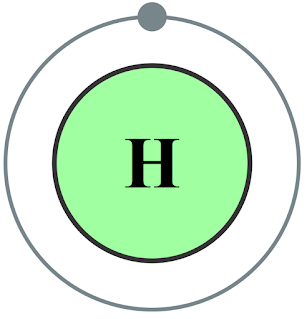Hydrogen, a chemical element with the symbol H and atomic number 1, is the lightest element in the periodic table with a standard atomic weight of 1.008. it is one of the most abundant chemical elements found in the universe. About 75% of all baryonic mass are roughly constituting hydrogen.
Hydrogen atom readily forms a covalent bond, it is mostly found
in a molecular form on the earth in the form of H2O or most organic compounds.
No doubts hydrogen is the most widely used chemical species in the world of
chemistry and it is uses literally everywhere in chemistry.
You are here to know valence electrons and the valency of the hydrogen atom, aren’t you? But for this, you have to know what these two terms
are, so without wasting your time let’s begin,
Difference Between Valence Electrons and Valency
Valence electrons are the total number of electrons present
in the outermost shell of an atom (i.e. in outermost orbital). The valence
electrons for a neutral atom is always definite, it cannot be varied (more or
less) in any condition for a particular atom and may or may not be equal to its
valency.
Valency is defined as the total number of electrons an atom
can lose, gain, or share at the time of bond formation to get a stable
electronic configuration i.e. to complete an octet. The valency of an atom can
be variable in different compounds or chemical reactions due to the different
bonding circumstances. Most of the time valency varies/changes due to change in
oxidation and reduction states.
Hydrogen (H) Valence Electrons
There are four simple steps to find out the valence
electrons for hydrogen atom which are:
Step 1: Find the Atomic Number
To find out the atomic number of hydrogen, we can use the
periodic table. With the help of the periodic table, we can easily see that the
atomic number of hydrogen is 1. As its atomic number is 1, it has one proton,
and for neutral hydrogen, the number of protons is always equal to the number of
electrons i.e. has only one electron in its nucleus.
Step 2: Write Electron Configuration
Electron configuration is the arrangement of electrons on
the orbitals. The hydrogen atom has only one electron on its shell, we have to
put only one electron in its orbital and that will go in the 1s orbital as the S
orbital can hold a maximum of two electrons, and is closer to the nucleus.
Hydrogen electron configuration H (H) = 1s1 (complete
configuration).
Step3: Determine Valence Shell
As we know, the valence shell of an atom can be found from
the highest number of principle quantum numbers which is expressed in the term
of n, and in 1s1, the highest value of n is 1 so that the valence shell of H is
1s1.
Step 4: Find Valence Electrons
The total number of electrons present in the valence shell
of an atom is called valence electrons, and there is only one electron present
in the valence shell of hydrogen (1s1). Thus, hydrogen has only one valence
electron.
Valency of Hydrogen (H)
There are many different ways to find out the valency of an
atom which reflects the ability of an atom to bond with other atoms. Valence
describes how easily an atom or a free radical can combine with other chemical
species. The valency of an atom is determined based on the number of electrons
lost, gained, or shared with another atom at the time of bond formation.
An atom is said to be stable when its outermost shells have
eight electrons (except H & He). If the total number of electrons in
outermost shells is between one to four, the atom has positive valency and if
electrons are between four to eight, the valency is calculated by subtracting
from eight and valency will be zero. Atoms having four outermost electrons
possess both positive and negative valency, and atoms having eight outermost
electrons, valency will be zero (i.e. noble gases).
Non-metal like hydrogen reaches the stable state (nearest
inert gas configuration) by losing one outermost electron. So that the valency
of hydrogen (H) is +1.
We can also find the valency of hydrogen with the help of the periodic table. As hydrogen belongs to group 1 along with the alkali metals
whose valency is always one.
Note: Hydrogen is not an alkali metal. it is a non-metal but
placed in the group of alkali metal in the periodic table based on its valence
electron. Never forget chemistry is a science of exceptions.
H+ Valence Electrons
Hydrogen-ion H+ means it has lost one electron and has no
electron left on orbitals. The electron configuration of neutral hydrogen is
1s1 but in H+ it loses one electron, so it has no electron left on the
outermost shell. Thus, H+ has zero valence electron.



Post a Comment